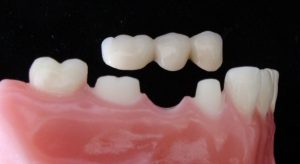Bridge or Tooth Bridge to replace missing teeth
A bridge, like an implant, can be perceived as a solid prosthesis that replaces one or more missing teeth. The bridge is stuck to the surrounding teeth, and the treatment - unlike an implant - does not require surgery in the jaw. Instead, you attach the bridge around the remaining neighboring teeth using a glue/cement. The bridge cannot be removed and will feel very similar to the natural teeth. In it it is stuck and has the shape of the natural teeth it will besides a natural feeling and give the same good chewing function as the right teeth.
When is a dental bridge used?
In order to make a bridge, it is necessary to grind around the teeth that will act as bridge pellets. This will in many cases be an unnecessary strain on these turns on and in that case you will instead recommend treatment with implant. However, there will be situations where a bridge will be the obvious choice. It will typically be in situtations where the teeth in question will still need a greater treatment. If the teeth have undergone root canal treatment or extensive repairs in plastic, it will be natural that these teeth are recommended crowns. Here a bridge could be a good and sensible treatment.
How does the treatment take place to a bridge?

A dental bridge consists of bridge pillars and intermediaries. The middle joint sits as the word suggests between the nocturnal teeth where teeth are missing. The bridge pillars are the term for the teeth that hold the bridge. Depending on the number of missing teeth, there may be two or more bridge pellets. Therefore, a dental bridge will always consist of a minimum of 3 contiguous teeth, two bridge pillars and an intermediary. However, bridges can be made in up to 16 joints if a whole upper or lower mouth requires treatment.
In order for the bridge to be attached to the teeth, the bridge pillars are sanded and subsequently imprints of bridge pellets and remaining teeth are taken. At the same séance, some temporary caps are prepared for the sledged teeth. Sometimes it is already possible to make a temporary bridge in a plastic material.
After this, the final bridge is produced by a dental technician and a few weeks after the first consultation the new bridge can be glued to the teeth.
A tooth bridge can be made to completely imitate the appearance of your own teeth. The technique for making a bridge is the same as for crowns and implants as they are all typically made in porcelain. In contrast, removable dentures are used, where teeth are typically produced in a plastic material. Treatment with bridges or implants to replace missing teeth is therefore also worth preferring for aesthetic reasons to a prosthesis.
What to choose?
The only absolute argument for a bridge rather than an implant is medical history. For example, if you are treated with high dose bisphosphonate, it will not be possible to put implants. But other medical situations can also rule out or complicate a treatment with implants. It is therefore very important that you inform us about your medical history in connection with the prior examination.
Another argument for choosing a bridge is time. It takes 2 -3 weeks to get a bridge made, while a treatment with implant can easily take 6 - 8 months. In the case of replacing more than one tooth, a bridge will also be significantly cheaper than treatment with implants. The reason why implants are recommended in many situations is to reduce the number of teeth involved and thus also the number of teeth that need to be repaired should a problem arise at some point. Clean maintenance around a bridge is also more difficult and time consuming than with an implant.
If the teeth that will act as bridge pellets are very worn out and have undergone extensive treatment already, a bridge will be a fine choice. In this type of situation you will typically recommend crowns for the worn teeth and if the crowns can at the same time act as bridge pellets it is an obvious choice.
If, on the other hand, the neighboring teeth of the missing tooth are intact and healthy, it would be best to avoid grinding them. This is because when a grinding of the tooth comes a risk of complications such as nerve inflammation, etc. In these cases, implants will typically be recommended.
Prior to any treatment, you will be presented with the different options and we will jointly find the solution that best suits you.
Do you need a tooth and want to hear more about the possibility of a bridge?
Call us
35427727
Or let us call you

